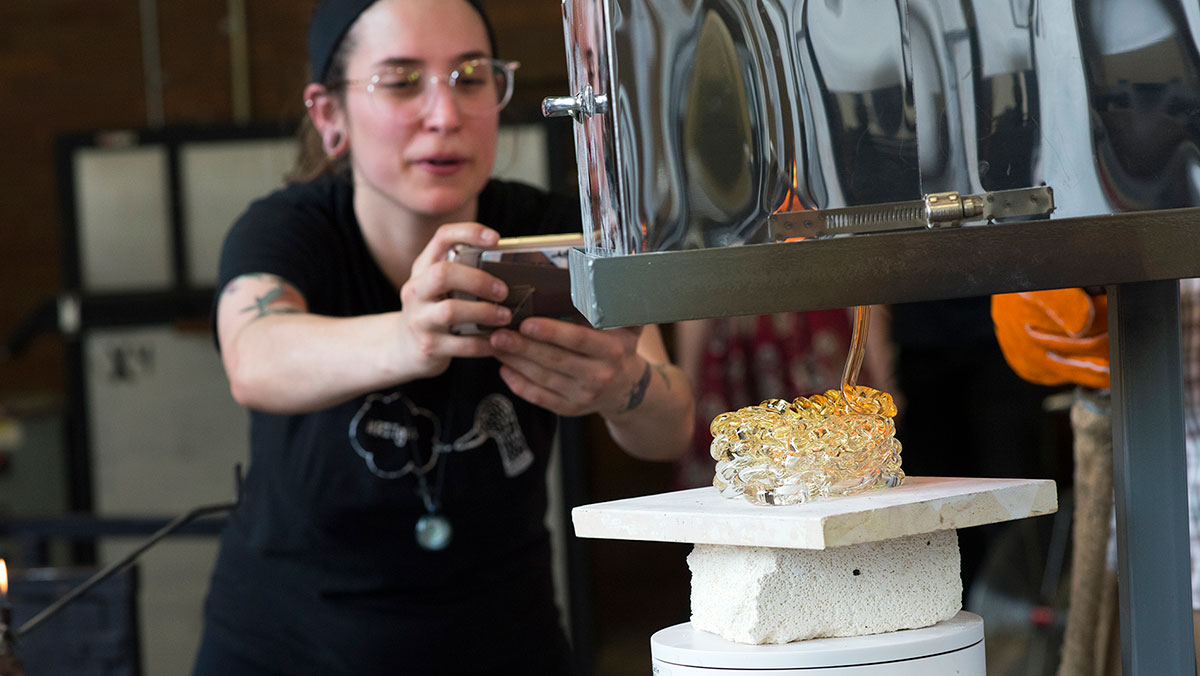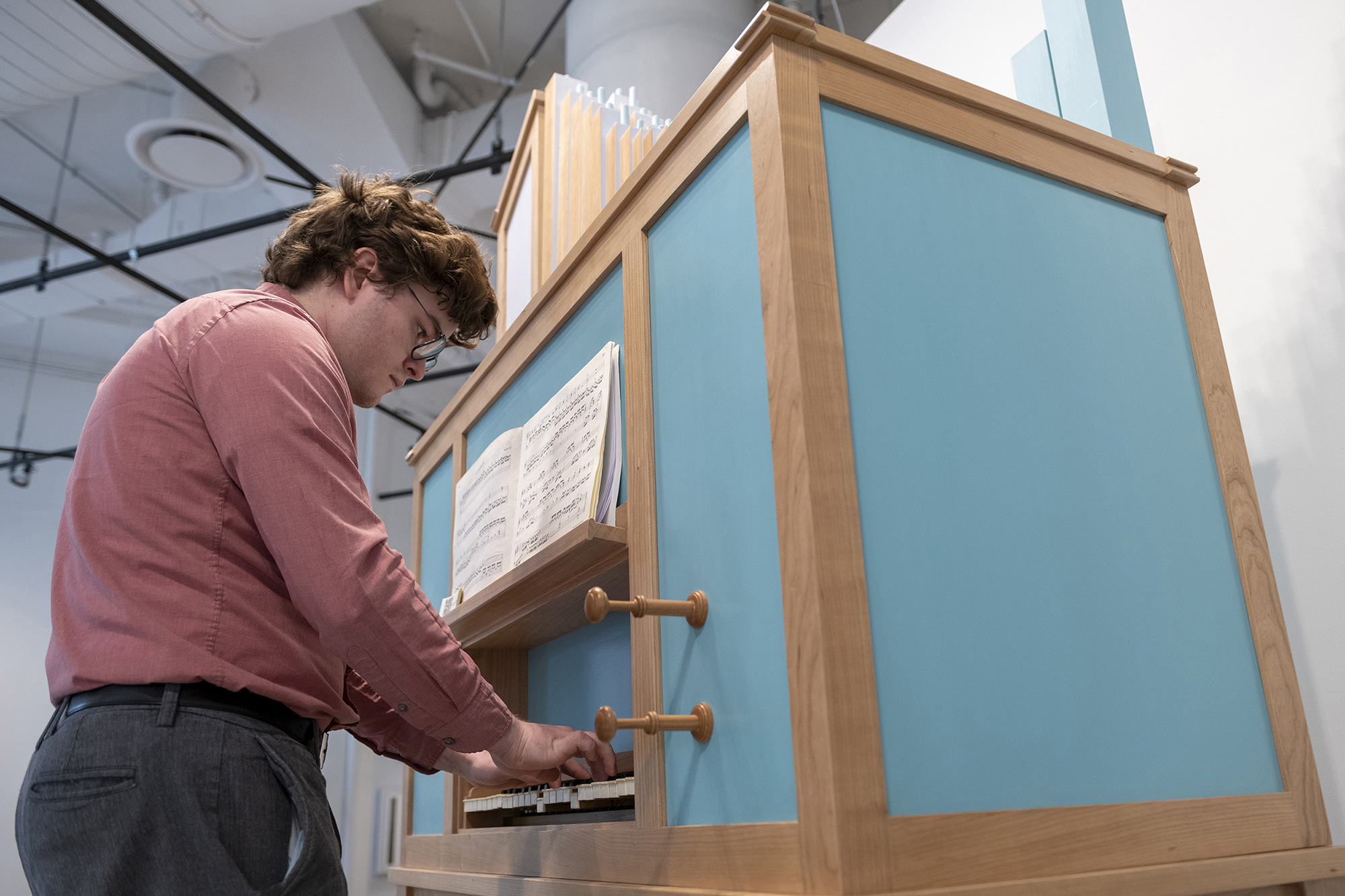Visual Arts and Media
Whether it’s telling a compelling story with still or moving images, 3D printing molten glass, writing a feature-length screenplay or creating prints incorporating live microorganisms into two-dimensional images, we’re always on to something uniquely amazing.
Combining Technology, the Arts and Design
Machines are whirring as hand tools chisel away and shape the finer details of woodworking projects.
The natural sounds of RIT’s furniture design studios exist within an active environment filled with imaginative makers. One year, crisp tones of classical music joined the symphony of sounds. The source of the sweet melody was a pipe organ handmade by Kelly Cleveland ’21 (Furniture Design) for his capstone project.
Cleveland paired woodworking skills with research and knowledge of other materials and disciplines to create every component of the 8-foot-tall, 5-foot-wide instrument — from 90 wooden pipes to the keys and their brass hinges to the sheepskin leather valves to the mechanical action connecting the keys and pipes. His blending of woodworking, metalworking and engineering came together to form an awe-inspiring crescendo that is hard to ignore, in both aesthetic and sound.
Cleveland's project is among countless examples of students blurring the line between technology and making in the art studio environment. From employing 3D printing and laser cutting to 3D modeling and motion-tracking software, students are incorporating tech-based artwork into their practices to expand the boundaries of what is possible.
Merging Contemporary and Traditional Practices
Students from majors across RIT fused historical knowledge, modern fabrication processes and various pottery practices to create replicas of ancient Greek vessels. The assignment was part of the Josiah Wedgwood's Legacy course, a ceramics class for non-majors that exemplifies RIT's strategic focus on technology, the arts and design. Taught by Assistant Professor Peter Pincus, the class explores parallels between innovative methodologies in ceramics and manufacturing in the 18th century and the role modern fabrication processes play in those fields today.
For the course's “Revisionist Antiquities” assignment students employed computer-aided design (CAD), 3D printing and laser cutting to make mold systems that can quickly and efficiently produce replicas of fourth-century Etruscan vessels. It's a style of pottery made widely accessible to all social classes by the course's namesake, 18th-century potter and social activist Josiah Wedgwood.
Documenting Bills Mafia
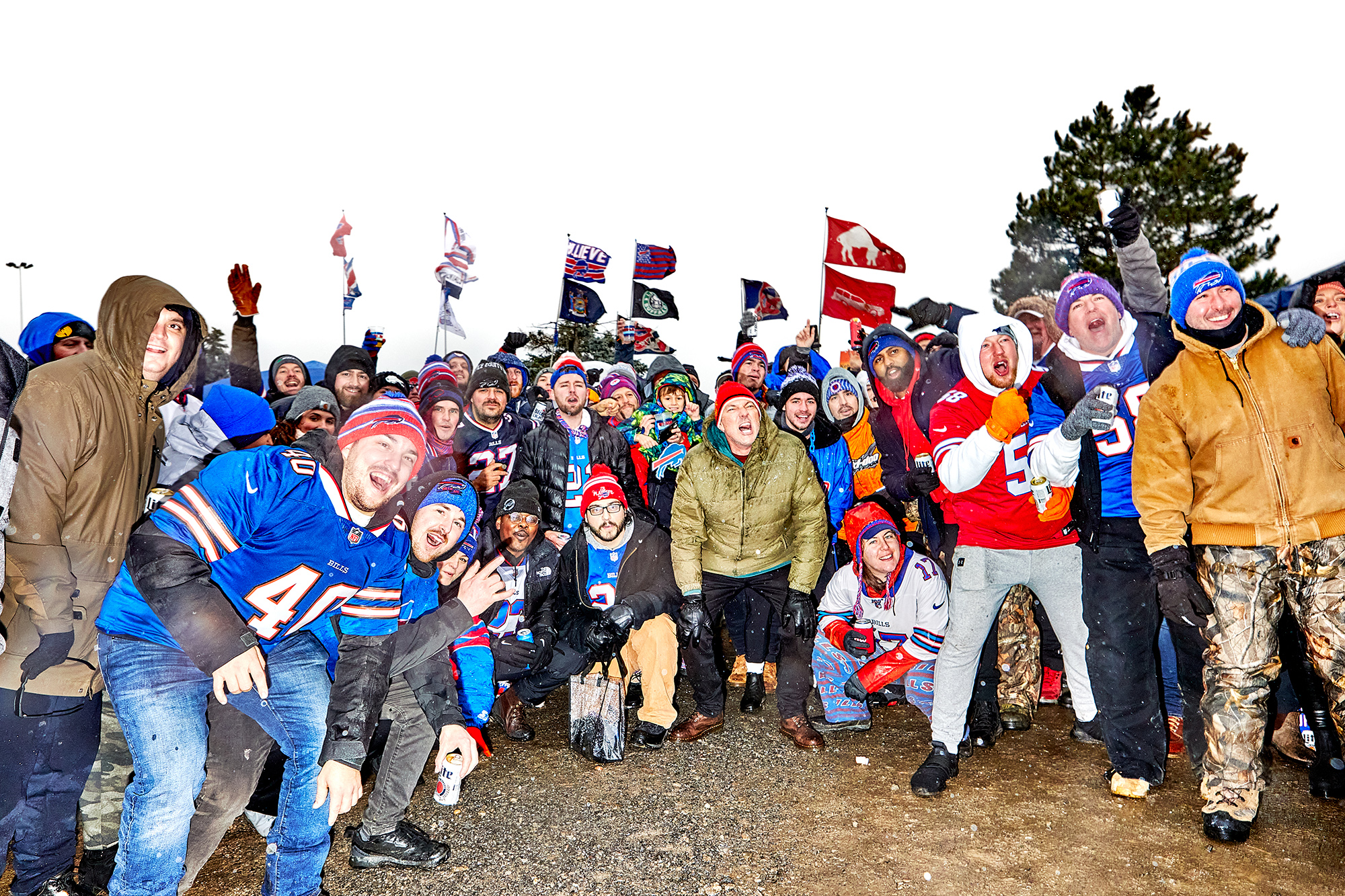
RIT students and faculty from the School of Photographic Arts and Sciences were hired by Sports Illustrated to capture the famed tailgate experience of Buffalo Bills games. Their photos of the NFL team's fan base — known equally for its wild parking-lot traditions and philanthropic spirit — appeared in a web story and headlined a six-page picture essay in the magazine's February 2023 print issue.
Senior Lecturer Clay Patrick McBride and students Abby Curtis '23 (advertising photography) Ariana Shchuka ’23 (photojournalism) and Vincent Alban ’23 (photojournalism) took on the freelance assignment, working together to make their way through an ambitious shot list in a nasty wintry mix that was no match for the talented team’s plastic-wrapped cameras.
“I was blown away at the quality of work from my crew,” McBride said. “Their images got to the heart and soul of Bills tailgating. In both the students and Bills Mafia, I see the same passion, insane dedication, and above all, a love for the game.”
Photo by Abby Curtis '23
Material-based Inquiry and Research
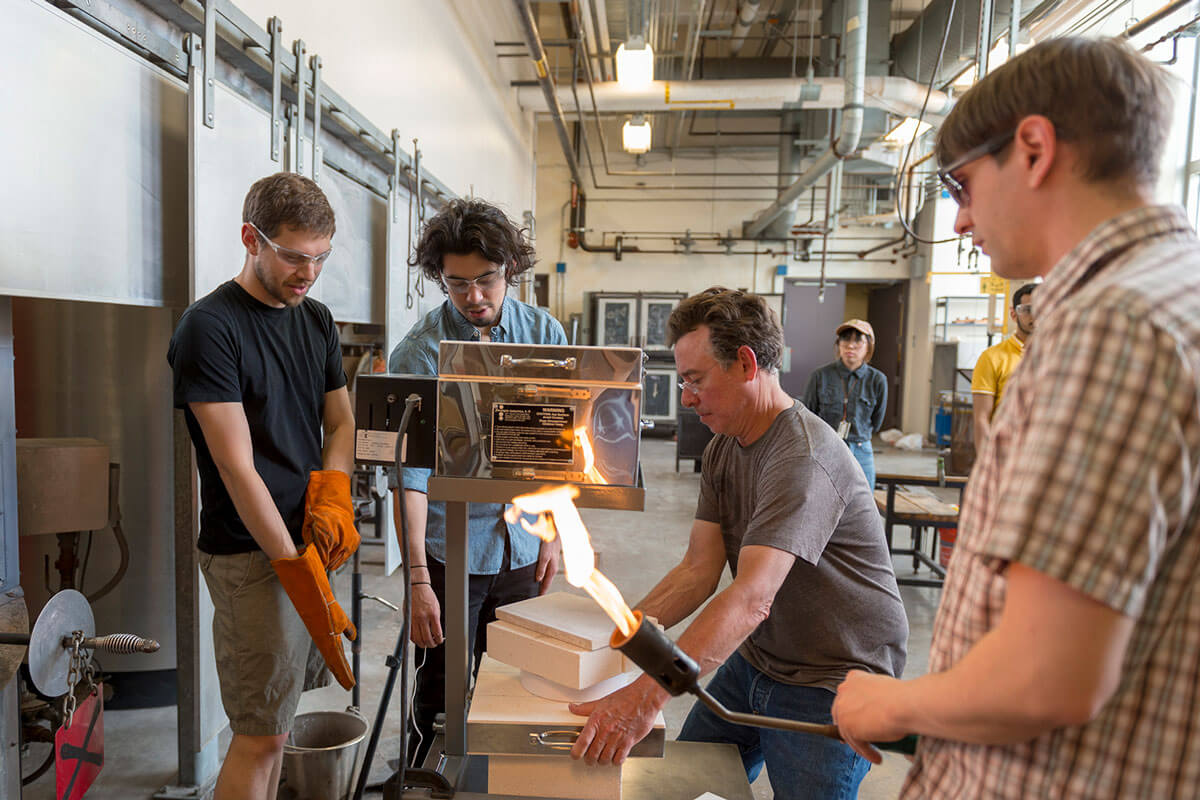
Acknowledging RIT as a place where technology, art and design intersect, the Glass program exemplifies the opportunities that exist in such a unique environment.
RIT Glass — which offers an MFA and a BFA option in Studio Arts — espouses a multidisciplinary approach and the use of outside resources, allowing students and faculty to investigate new possibilities. Each semester, the program introduces a different research theme for students to think about various concepts in their studio practice. The semester research theme is prevalent in studio instruction, critiques and the Visiting Artist Lecture Series, which invites professional artists from around the world to campus or an online space for discussions and demos.
A marquee example of the program’s studio research was a collaboration with RIT’s Munsell Color Science Laboratory that explored the philosophical study of color. Working with the color science lab on campus, students broadened their thinking of color beyond its typical, tangible application and applied it to their studio practice. Additionally, the program put technology, art and design on full display when it hosted the engineers who invented the world’s first molten glass 3D printer for a lecture and demo recreating the early days of the project.
Documenting Contemporary Greenland

For more than a year, RIT School of Photographic Arts and Sciences Professor Emeritus Denis Defibaugh lived in Greenland, completing research on a National Science Foundation (NSF) grant. Traditionally not awarded to those in the arts, the NSF grant allowed Defibaugh to explore and document the large island. Through his photography, he supplied an intimate, contemporary look at the people and primal geographic landscapes of Greenland.
Defibaugh’s Greenland photography project focused on the work of Rockwell Kent, the famous artist and writer who spent several years in Greenland in the 1930s creating art and literature about his experience. That body of work was used as a starting point for Defibaugh to engage community members in the Greenland communities of Illorsuit, Sisimiut, Nuuk and Uummannaq. Defibaugh’s documentary photographs introduce a changing country and its cultural continuity in response to Kent’s historic writings and hand-tinted lantern slide images made during his residence in Greenland.
Pushing the Boundaries of Printmaking
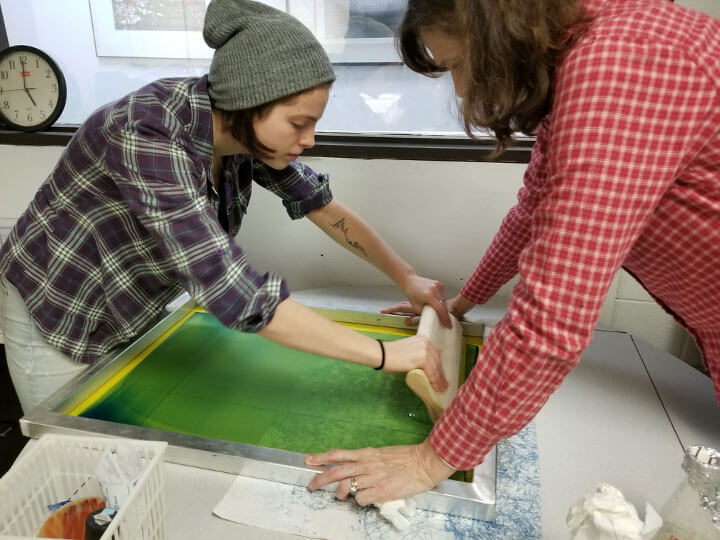
School of Art Professor Eileen Feeney Bushnell led a research project that investigated using microbes in printmaking. Funded by an AdvanceRIT Connect Grant, Bushnell’s research team consisted of Jennifer Liedkie, senior lab specialist in the Thomas H. Gosnell School of Life Sciences, and then-students Sarah Kinard (Fine Arts Studio MFA) and Erika McCarthy (Fine Arts Studio BFA).
Inspired by her heavy interest in the sciences, Bushnell saw an opportunity to merge art with environmental science. The team created an experimental series of prints incorporating live microorganisms and related representational forms into hybrid two-dimensional images. Through the research, the team tangibly explored contemporary biological, scientific and cultural issues.
They experimented with the growth of microorganisms that related conceptually and geographically to concepts and forms being explored in artwork. Biological forms and their inherent characteristics of color and growth patterns were integrated into the creative work.
The project wasn’t scientific inquiry by its standard definition, but rather an exploration of life in another paradigm, which revealed new ways of seeing and thinking. Bushnell found the experimentation with 4D imagery in a traditionally static discipline expanded the potential of printmaking and the direct integration of contemporary cultural issues.




